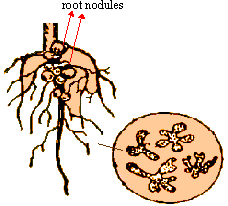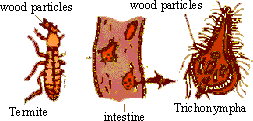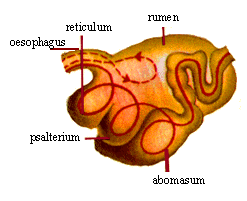|
PinkMonkey Online Study Guide-Biology

Figure 14.26 Root tubercles
3. Termites and flagellates : Several species
of flagellates (protozoa) are found in the gut of termites where they
participate in the digestion of wood. Termites feed on wood but are unable
to digest it due to absence of proper enzymes. The flagellates present
in the intestine digest wood with specific enzymes they secrete. The flagellates
have no mouth or gullet; food particles are engulfed by pseudopodia at
the posterior end. They convert the cellulose of wood into sugars. They
use some of the sugars but much is left for the termites. The termites
cannot survive without their intestinal flagellates. Newly hatched termites
lick the anus of other termites to obtain flagellates. The flagellates
in return get protection, food and lodging. Thus, the flagellate and termite
live together for mutual benefit.

Figure 14.27 Termites and Flagellates
Ruminant stomach : Cud chewing animals like cow,
sheep, goat, deer, giraffe etc. are called ruminants. They are herbivores.
In these animals while grazing, food is cut into large pieces and swallowed
without mastication. When at rest, the cud (i.e. the food once swallowed)
is regurgitated into the mouth for thorough mastication, a process called
rumination, or chewing the cud.
In adaptation to this peculiar food eating habit the stomach of a ruminant is very modified. It consists of four interconnected chambers such as (i) rumen or pouch (ii) reticulum or honeycomb (iii) psalterium or manyplies or omasum and (iv) abomasum or runnet.

Figure 14.28 Ruminant stomach
The rumen is the first chamber in which food is received
without mastication. The rumen is much enlarged and serves not only as
a storehouse of food that is swallowed without mastication but also acts
as a fermentation chamber due to its high contents of microbes. These
symbiotic microbes digest cellulose which the ruminant cannot hydrolyze
due to lack of cellulase. They also digest lipids into fatty acids and
synthesize vitamin B. Absorption of these products by the rumen provides
a significant amount of energy to the animal.
|
Table of Contents
14.0
Introduction
14.1 Kingdom
: Monera
14.2 Kingdom : Protista
14.3 Kingdom : Plantae
14.4 Kingdom : Fungi
Chapter
15
|